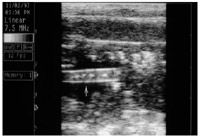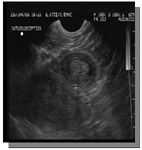Acute abdomen in foals: Emphasis on the ultrasound (Proceedings)
Abdominal pain in the foal can be a frustrating diagnostic challenge as the differential diagnosis are extensive. Abdominal pain can progress rapidly leading to septicemia or even death.
Abdominal pain in the foal can be a frustrating diagnostic challenge as the differential diagnosis are extensive (See Table 1). Abdominal pain can progress rapidly leading to septicemia or even death. The approach to the neonate with a painful or distended abdomen includes history, type and dose of analgesics, administered and whether there are any animals affected with diarrhea. Surgical versus medical treatment may be determined with a proper history and physical exam. Mild signs of colic ( Example: Meconium Impactions or Rotavirus) may include restlessness, attempts to defecate, swishing the tail, straining to urinate/urinating frequently, walking around the stall and not nursing. Severe colic signs should not be ignored and may include bloating, lying down and rolling, abdominal distention, and full body sweat. Immediate placement of a stomach tube should be performed in any foal that had chronic mild signs or colic or violently colicky. The age of the animal is also important in the determination of risks of certain conditions.

Differential diagnosis of the foal with abdominal pain
During the first 6 to 24 hours of age, congenital atresia of the colon, rectum, anus or meconium impactions are the most frequent causes of colic. In paint foals that are primarily white and whose dam and sire are overo are at risk for ileocolonic aganglionosis. Meconium is composed of glandular secretions from the gastrointestinal tract, amnionic fluid and cellular debris, which should be passed by 24-36 hours of age. In utero sepsis with associated hypoglycemia and sympathomimetic release can have bowel hypomotility and be at high risk for meconium impactions. Meconium impactions are more common in colts because of their narrow pelvic canal. The diagnosis of meconium impactions can be achieved by contrast radiographs, abdominal ultrasonography and/or proctoscopy. If routine warm water enemas do not relieve the impaction then hyperosmolar solutions (Hypertonic saline 3-4ml/kg per rectum) or acetylcysteine retention enemas may be used. The animal is usually first sedated with either xylazine or valium. I prefer valium at a dose of 0.1 mg/kg IV , because this medications causes minimal hemodynamic changes in the patient. The use of Buscopan (N-butylscopalammonium bromide 20mg/ml- Boehringer Ingelheim) at a dose of 0.1-0.2 mg/kg IV can also be used to help decrease the gastrointestnal "spasms" that may be occuring at the junction of the meconium impaction. These hypermotile segments will relax allowing the enema to flow around the impaction resulting in its resolution. The acetycysteine enemas consists of mixing 200ml water, 8 grams of acetylcysteine powder, and 20 g of sodium bicarbonate OR 40 ml of 20% acetylcysteine with 160 ml of water. A well lubricated 12 or 14 Fr, cuffed Foley urinary catheter is introduced into the rectum and the cuff inflated. 200 ml of the retention enema solution is then slowly infused and the end of the catheter plugged. The catheter is then taped to the foal's tail and left in place for 15 minutes. These enemas can be repeated several times a day. If using the hypertonic solutions for more than 2 treatments in a 24-hour period the sodium status of the patient should be re-evaluated to prevent hypernatremia. Additional therapy includes fluids and laxatives (120 ml of mineral oil SID to BID and/or milk of magnesia 30ml PO QID). Analgesics , such as flunixin meglumine 1.1mg/kg IV SID and butorphanol tartrate 1-2mg IV/IM Q 4-12 hours, may also be necessary to help control the foal's discomfort.
Older foals 2-5 days of age are more likely to be suffering from intussusceptions, ruptured bladders, enteritis, gastroduodenal ulceration, inguinal hernias and small intestinal volvulus. Ultrasonography can be used to help diagnosis conditions that may be causing colic. Dynamically distended small intestine > 2.5cm in diameter with no motility and absence of gastric distention could be suggestive of a small intestinal volvulus. A large amount of peritoneal fluid with a history of infrequent urinations is suggestive of a ruptured bladder. Unfortunately severe abdominal pain is not pathognomonic for a surgical lesion. Tachycardia of excess of 120 beats per minute that is non-responsive to pain medication and in the absence of fever is suggestive of a surgical lesion.
Small intestinal obstruction
Clinical signs of small intestinal obstruction may include severe colic signs, bruxism, reflux from nares (Most clients may think this is mucus), gastric and small intestinal distention. Laboratory findings are usually non specific with minimal electrolyte disturbances and dehydration secondary to compartmental fluid losses. Use of diagnostic ultrasound will reveal hypomotile loops of small intestine with diameters exceeding 2-3 cm. (Figure1)

Figure 1: Dynamically Distended Small Intestine in a 4 month old foal with a small intestinal volvulus. Note the edema of the serosal surface
If no motility and edema is noted on the abdominal ultrasound examination then surgical exploration will be warranted.
Ascarid impactions
Ascarid impactions usually occur in foals that are 3-5 months of age. The majority of these cases occur in the foal with 54% of the cases having a history of being dewormed 6 days before the onset of clinical signs. Ascarid impractions have a poorer prognosis for long term survival when compared to other colic surgeries. The reason for the poor prognosis is not exactly known but is thought to be related to the toxins that are released by the ascarids leading to prolonges ileus. Occasionally ascarids can be detected in the lumen of the small intestine or in the animals reflux

Figure 2: Ascarid in the lumen of the small intestine (arrow)
Intussusception
Foals with an intussusception (Jejunal, Ileal Cecal, Cecocolic) can have signs that are initially intermittent low grade pain which may progress to violent pain. We have diagnosed foals with jejunal intussusceptions that have corrected on their own while the foal was maintained on maintenance intravenous fluids, nonsteroidals and restricted feed consumption. If the foal is not showing severe signs of colic then the intussusception will be serially monitored with transabominal ultrasound for signs of edema. If edema is noted and colic signs worsen then surgical exploration will be pursued. Abdominal ultrasound will reveal "bulls eye" lesion caused by the intussusceptum (inner part) and the intussuscipiens (outerpart).

Figure 3. Foal with a jejunal intussusception that had a heart rate of 120 BPM and refluxing. Surgical correction was warranted. Note the marked edema of the intussuscipiens.
Large colon obstructions
Clinical signs can be very similar to small intestinal obstructions. Excessive bloating is characteristic of animals that are suffering from a meconium impaction. Large colon torsions may also be bloated and but when it is an acute "twist" the animal will show signs of severe colic with minimal bloating.
Large colon torsion
Clinical signs may include severe pain, tachycardia, profuse sweating, and bloating. Diagnostic ultrasonography is not useful for diagnosis but is useful to help rule out other causes of colic. The animal that is non responsive to pain medication should have surgical exploration.